Contents
1. Divisions of the Veda
‘मंत्रब्राह्मणयोर्वेदनामधेयम्’ means literature composed of the mantra part and the Brahman part of holy texts are the Vedas (Apastamba Paribhasha 31). Grossly every Veda is divided into four parts – the Sanhitas, Brahmans, Aranyaks and Upanishads. The Sanhitas comprise of the mantra aspect and the Brahmans, Aranyaks and Upanishads, the Brahman part. The Aranyaks and the Upanishads are a part, that is an epilogue of the Brahman holy texts. However because of the method of writing and the linguistic pattern they are considered to be different. The Aranyaks and Upanishads were basically parts of the Brahman holy texts. Only the Ishavasyopanishad is a part of the Sanhitas.
The Ayurveda is called the fifth Veda.
1.1 The Sanhitas
The part which has to be learnt by rote by a student in the Guru’s hermitage (ashram), during the stage of celibacy is referred to as the Sanhita. In the Shruti (Veda) rules of religious scriptures appear concomittantly. Different Sanhitas give important tenets on marriage and its types, categories of sons, the rite of adoption, division of wealth, division of inheritance, the rite of shraddha for the departed ancestors, a woman’s personal property, etc.
1.2 The Brahman holy texts
A. Meaning: ‘The word Brahman (ब्राह्मण) when neuter in gender means a holy text (ब्रह्मणं ब्रह्मसङ्घाते वेदभागे नपुंसकम् ।). The word Brahman was used in the context of a holy text first in the Taittiriya Sanhita (3.7.1.1).
The word Brahman (ब्रह्म) is also used ordinarily to refer to a Veda or a mantra in Vedic literature. Hence Brahman means the Vedas and that which imparts the knowledge of Brahman are the Brahman holy texts.
The basic meaning of the word Brahman is the commentary of a Vedic scholar on a subject from among the rituals in a sacrificial fire (yadnya). The holistic meaning of the word is taken as the collection of discussions and commentaries of those performing sacrificial fires on rituals from the sacrificial fire.
Brahman also means a sacrificial fire. It is because of this very reason that the focus of the Brahman holy texts is upon prescribing the method of ritualistic worship of sacrificial fires. In these sacrificial fires, besides suggesting which mantra to chant, the significance of chanting it with that particular act is also explained. The Brahman holy texts chiefly explain which mantra is to be chanted with which act, that is why they are a science of practical utility. The Brahman texts can be described as a great encyclopaedia containing scientific, physical and spiritual concepts. Along with sacrificial fires the Brahman texts also discuss different sciences related to sacrificial fires.
B. Content: These texts encompass mainly three topics that is rites, prohibitions and argumentation philosophy.
Description of sacrificial fires: The Brahman text gives a vivid description of the sacrificial fire to be performed daily by one who has accepted the Agnihotra vowed observance. Apart from the Agnihotra, Darshapurnamas, Chaturmasya, Somyag and other sacrificial fires, great fire sacrifices like Ahin, Satre, etc. are also explained in detail. A mention of sacrifices performed for fulfillment of desires (kamyayag) is also made. These texts also give details of different rituals to be performed in all the above sacrificial fires. This part is called the ‘ritual section’ of the Brahman texts.
Prohibition of non-actions : They also state which acts are inappropriate.
The philosophy of argumentation: A large section of these texts is constituted by the philosophy of argumentation. The four main types of this philosophy are – praise, criticism, actions performed by others and an account of events which have occurred in the previous kalpa (a period of time comprising of 1000 turns of the four yugs).
Since the Brahmans are the first holy texts to attempt to give an explanation of mantras they are referred to as the pioneer holy texts giving commentaries of mantras. Apart from the use of particular mantras for particular actions the Brahmans also explain how the meaning of the words in the mantra harmoniously blends with the action being performed with great expertise.
C. Authority: The Vedas or their branches can be classified into two sections – the Sanhitas in the form of mantras and the Brahmans in the form of discourses or statements. Though according to the time the composition of the Brahmans follows the Sanhitas, the Brahmans are included in the divine holy texts.
D. The time period: The Brahmans have tried to explain the meaning of mantras from the Sanhitas and their conversion into various actions (karma). That explicitly illustrates that the Brahmans were written after the Sanhitas. However some Sanhitas are in a mixed form with mantras and resemble the Brahmans; hence they are believed to be written during the Brahman period.
Astrology is a better science than philology or the description of various ritualistic actions in determination of the time. In the Brahman texts Kruttika is believed to be the first lunar asterism (nakshatra). The text Shatpath (2.1.2.3) states that this lunar asterism never vanishes from the east. The lunar asterisms from Kruttika to Vishakha are the lunar asterisms of deities while those from Anuradha to Bharani are the lunar asterisms of Lord Yama (the deity of death). In other words to the northern side of the equator are the lunar asterisms of deities and to its south are the lunar asterisms of Lord Yama. The same is described in the Taittiriya Brahman texts. Research carried out in this connection infers that the Brahman texts must have been written before 2000 B.C. Lokmanya Tilak has estimated the period of the Rugveda to be approximately 4000 years B.C. From this it appears logical that the Brahman holy texts must have been written around 2000 years B.C.
E. Some Brahman holy texts: Though there are several Brahman texts written on the different Vedas the ones available nowadays are given below.
Brahmans of the Rugveda: There are two Brahman holy texts associated with the Rugveda. They are 1. Aitareya and 2. Shankhayan. The Aitareya Brahman elaborates on the Somyag, Dvadashaha, Satre, etc. Shunahashep’s famous discourse is included in this Brahman. A Shankhayan Brahman is also called the Kaushitaki Brahman. This Brahman text describes the ritual of worshipping fire (hautrakarma) to be performed during the Agnihotra, Chaturmasya, Somyag, Ahin, Satre and other sacrificial fires.
Brahmans of the Yajurveda: The Shukla Yajurveda has two branches – 1. Madhyandin and 2. Kanva. The Brahman holy texts of both these branches are available but there is hardly any difference between them. The Brahmans of both the Madhyandin and Kanva branches of the Shukla Yajurveda are known as the Shatpath. Since this Brahman has a hundred chapters it is named so (shat means 100; pat means chapters). The Shatpath Brahman is the biggest and most important of all the Brahman texts. Yadnyavalkya is considered as its author. It is the oldest of all the Brahman holy texts available today.
Though the Krushna Yajurveda has four branches the Brahman texts of only the Taittiriya branch are available today. The Taittiriya Brahman exists in a mixed form as a mantrabrahman since it includes some mantras which are discussed in the Sanhitas and many from the Sanhitas are discussed in this Brahman.
Brahmans of the Samaveda: Currently the Samaveda has three branches. Of them there is absolutely no difference between the Kauthumi and Ranayani branches. Hence their Brahman texts are common. The third Jaimini branch has its independent Brahman. It discusses various aspects of a samagan such as those which are to be sung during fire sacrifices, how they acquired those names, the importance of samagan in fire sacrifices, etc.
Brahmans of the Atharvaveda: The Atharvaveda has two branches – the Shaunak and the Paippalad. But today only one Brahman, the Gopath Brahman is available. This Brahman must be of recent origin.’(1)
F. Theology
1. From the theological viewpoint deities from the Sanhitas are mentioned in the Brahmans but in the latter there is a great difference between the status, whether superior or inferior. Subordinate deities from the Rugveda such as Shiva, Vishnu and Prajapati are accorded a superior status in the Brahmans.
2. In the ancient times a sacrificial fire (yadnya) was a means of worshipping deities; but today it has become the end.
G. Importance of a sacrificial fire: ‘The main trend of thought from the Brahmans is that performing a sacrificial fire is the greatest of all actions. In some contexts a sacrificial fire is said to be effulgent like the Sun deity while in others it is considered to be Prajapati (Shatpath Brahman 4.3.4.3, 14.1.1.6). By performing a sacrificial fire, man is liberated from all sins. The one performing the Ashvamedh sacrificial fire is liberated even from the sin of killing a Brahman (priest). A sacrificial fire fulfills the worldly pursuits of man and even helps him to attain heaven (svarga). All those performing meritorious actions acquire merit. The only means of being liberated from the cycle of rebirth and death is a sacrificial fire (Shatpath Brahman 2.3.1.6, 13.5.4.1). Recitation of Vedic mantras steadies the mind and makes it strong. Chanting of mantras changes the environment completely and causes the cycles of Righteousness (Dharma) to become established in the entire universe (Aitareya Brahman 1.4.3). Fire sacrifices based on the Brahman texts were performed both at home and in the villages.
H. Social and cultural thinking: Though the primary objective of the Brahman holy texts is holistic contemplation on sacrificial fires, it includes definition and explanation of words, the family trees of kings, teachers and sages and different apologues and sub-apologues. Some social and cultural trends of thoughts of sages belonging to the Brahman era are projected through them.’(2)
1.3 The Aranyaks
A. Definition: ‘In the commentary on the Aitareya Aranyak Sayanacharya says – “अरण्ये एव पाठ्यत्वादाण्यकमितीर्यते । meaning the Aranyaks are holy texts to be studied in the stage of a retired householder (vanaprasthashram)”.The Aruneya Upanishad states that in the state of a retired householder out of the Vedas only the Aranyaks and the Upanishads should be studied. When imparting knowledge to students about recitation of the Aranyaks along with the correct method of their pronunciation, they were instructed in a forest instead of doing so in a village. Even today it is preached only in the temples.
B. Content: The Aranyaks do not include sacrificial fires rather the analysis of facts of Spirituality associated with them. A sacrificial fire is not a rite but a concept from the Darshan included in it. All the Aranyaks are the concluding chapters of the Brahman texts. The chapters from it which explain philosophies are called the Upanishads. If examined minutely then it is obvious that the discussion from the Aranyaks is closer to the Upanishads than the Brahman texts.
Description of the divine and spiritual forms of sacrificial fires (yadnya) is their chief objective. They explain the mysterious and implied meaning of sacrificial fires. The language from the Aranyaks is simple, abridged and explains rituals. They emphasise more on the sacrificial fire performed psychologically than the actual ritual. The definition of a sacrificial fire from the Darshans is given here. They advocate that a sacrificial fire is the controller and also responsible for the welfare of animate and inanimate creation. There is no faith in actions with expectation (sakam karma) and the result of actions (karmaphal) in these scriptures. According to the Aranyaks the Path of Action above is insufficient to bestow supreme happiness. It has to be combined with the Path of Knowledge. It is the revolutionary mission of the Aranyaks to reduce man’s desire and faith in external rituals and to divert it to worship with the mind.
The Aranyak literature is one which unites the Vedange (sciences related to the Vedas) and the Brahmans. Various routine ritualistic actions (nityakarma) described in the Gruhyasutra or similar to them are described in the Aranyaks (Taittiriya Aranyak 2.11). Some rules regarding pronunciation are also mentioned in it (Aitareya Aranyak 2.2). Thus the ancient form of education (shiksha) is seen in the Aranyaks. Concepts such as good and bad omen not described in the Vedange (sciences related to the Vedas) but which appear in the literature which followed them are found in these scriptures.’(3)
1.4 The Upanishads
A. Origin and meaning: The word Upanishad (उपनिषद्) is derived by prefixing the prepositions upa (उप) and ni (नि) to the root word sad (सद्). Sad means to sit down and upa means near, so the word Upanishad means to sit close. The spiritual knowledge acquired by a disciple by sitting with his Guru, with intense devotion and spiritual emotion is known as the Upanishad.
B. Synonyms: Since the Upanishads come last in the hierarchy of Vedic literature they are also known as the Vedanta (anta = end). Apart from this since they constitute the part of spiritual knowledge (dnyankand) of the Vedas they are also known as Brahmavidya (science of Brahman). In the further period masters of the Vedanta divided it into three separate disciplines (prasthan) for the attainment of God. They are the Shrutis, Smrutis and Nyaya. The Upanishads consist of the Shrutiprasthan, Bhagvadgita, Sanatsujatsanhita, etc. form the Smrutiprasthan and aphorisms such as the Brahmasutra, etc. constitute the Nyayaprasthan.’(4)
C. Subject: ‘The Aranyaks illustrated the psychological aspect of performing various ritualistic actions (kriya karma). Continuing on these lines later the Upanishads which expressed the futility of ritualistic actions and advocated Self-realisation as a means of fulfillment of the pursuits of human life were written. Just as the Brahman holy texts are devoted to the science of sacrificial fires (yadnya), the Upanishads are the foremost holy texts devoted to philosophy. The objective of creating the Upanishads was to revolt against the institution of sacrificial fires. Basically both the Aranyaks and Upanishads being a part of the Brahmans it is extremely difficult to demarcate between them. Nevertheless priests, philosophies on Righteousness (Dharma), occult philosophies on sacrificial fires and philosophy of symbols are the general features of the Aranyaks. To some extent these features have been carried forward into the Upanishads as well. But the core of the Upanishads consists of discrimination between the soul principle and that which is not, the search for creation of the universe, nature of the God principle, research on the principle of the embodied soul (jiva), eternal happiness and the means of attaining it.’(5) ‘Since the Upanishads preach philosophies they are also known as Brahmavidya. The Upanishads discuss topics such as what is Brahman, how and why the manifestation (illusion) of the universe occurs in Brahman, how to attain Self-realisation, the nature of the soul, the secret of non-duality of Brahman and the soul principle with elaborate detail.
The Upanishads primarily discuss the three topics of Righteousness, creation and the principle of the ultimate object, that is the soul (atma) or The Supreme Soul (Paramatma). The Upanishads consider the soul or Brahman to be the ultimate and eternal goal. A quote from the Mundakopanishad (1.1-3) is “कस्मिन्नु खलु भगवो विज्ञाते सर्वमिदं विज्ञातं भवति । meaning that principle after realising which one acquires the knowledge of all other subjects”.
The Supreme Soul (Paramatma) is referred to as the Hiranyamay Purush in the Upanishads. In the Sanhitas and Brahmans importance is endowed to the stage of ritualistic worship (karmakand) and these rituals constitute the fire sacrifices in them. The Upanishads have proclaimed that the Final Liberation (Moksha) is the ultimate form of happiness in comparison to which all other forms of happiness are worthless. They define the Final Liberation as the liberation from the bondage of the cycles of birth and death. It is these very holy texts which performed the important task of drawing man from the manifest deities such as Indra, Varun, Surya, Agni, etc. to the formless Brahman. The word soul, Supreme Soul or Supreme Brahman are generally used synonymously and refer to the same Principle. They propagate the concept that Brahman exists in every particle of Nature just as the absolute ether element is present both within and outside the human body.
During the period of the Upanishads the society considered performing sacrificial fires (yadnya) as the ultimate code of Righteousness (Dharma) and craved to obtain material pleasure on the earth and in life beyond in the other regions. Authors of the Upanishads placed different ideals before the people, showed them the subtle form of Righteousness and taught them how in life the greatest happiness lies in sacrifice and not in enjoying worldly pleasures. Liberation from the bondage of the cycles of birth and death is the real enigma of human life and the Final Liberation is its sole and ultimate solution.
Hence the Upanishads preached righteous conduct, the necessity to develop good qualities, glorified sacrifice and penance and proclaimed that only attainment of the knowledge of Brahman is the fulfillment of life. Several doctrines from the Upanishads are contradictory to one another. The Supreme Soul is of the nature of Bliss while the soul is tormented with unhappiness. The Supreme Soul is omnipotent while the soul possesses limited energy. As a consequence of these contrasting concepts the various Darshans on duality (dvait), qualified non-duality (vishishtadvait), non-duality (advait), etc. came into existence from the Upanishads.’ (6)
D. Special features: ‘Vedic literature written before the Upanishads was not intellectual. The queries and doubts in it are not logical. They seem to be influenced by religious faith to a great extent. However in the Upanishads intellectual concepts which transformed that faith and theology came into existence. Rarely does one find the concept expressed in the Upanishads that spiritual knowledge is that which is propounded by God and those who are enlightened with divine grace. But one thing which one should realise is that in the Upanishads the concepts described are for varying spiritual levels.
However the level of philosophy is the most important and striking concept and is noticed at once. Though actual subtle experience is accorded a high status in the Upanishads they do not oppose the concepts of logic. As intellectual analysis and logical deductions began in the Upanishads they did not attain the well established status as in the Darshans. The Upanishads are forerunners of the organised Darshans. It is from them that later the famous ancient group of Darshans originated.
The concepts from the ancient Upanishads are on the borderline of non-dual materialism (advait-jadvad) and the non-dual philosophy of divine consciousness (advait-chetanavad). They shed light upon the very core of both the Darshans.’(7)
E. The main Upanishads: ‘According to an account in the Muktik Upanishad there are 108 Upanishads in all. Elsewhere the number is quoted as upto 250. The Upanishads on which Shankaracharya has written commentaries are considered as the most important ones. They are the 1. Ish, 2. Ken, 3. Kath, 4. Prashna, 5. Mundak, 6. Mandukya, 7. Taittiriya, 8. Aitareya, 9. Chandogya, 10. Bruhadaranyak and 11. Nrusinhapurvatapani Upanishads.
F. Others: Some Upanishads are in the form of mantras and others in prose. The former have mantra notes and the latter have Brahman notes. They are studied accordingly. The period from 1200 to 600 B.C. is considered as the period of the Upanishads.’(8)
1.5 Parts of every Veda
‘The disciple lineage of Sage Vyas preserved the Vedas; however in the process several branches emerged amongst them. Several texts on aphorisms (sutras) were written on each branch of the Veda with the aim of describing rituals. Different branches came into existence according to the Sutras which they followed. Most of these branches were more or less similar to each other but over the passage of time many of them faded into oblivion. The table below gives the branches of the Vedas available today along with their Brahmans, Aranyaks and Upanishads.
| Rugveda | Yajurveda (Shukla) |
Yajurveda (Krushna) |
Samaveda | Atharvaveda | |
| The Sanhita |
Shakal, Bashkal (Trutit) |
Madhyandin, Kanva |
Taittriya, Maitrayani Kathak, Kapishthal |
Kauthum, Ranayani, Jaimini |
Shaunak, Paippalad |
| The Brahman text |
Aitareya, Kaushitaki (Shankha- yan) |
Shatpath (Madhyandin) Shatpath (Kanva) |
Taittiriya | Tandya Maha- brahman (Pancha- vinsha), Shada- vinsha, Vansha, Sama- vidhan, Arsheya, Mantra daivat, Sanhito- panishad Jaimini (Talavakar) |
Gopath |
| The Aranyak |
Aitareya | Bruhadaranyak (Madhyandin), Bruhadaranyak (Kanva) |
Taittiriya Maitrayani |
– | – |
| The Upanis- hads |
Aitareya, Bashkal, Kaushitaki |
Bruhadaranyak , Ishavasya, Shivasankalpa |
Taittiriya, Maha- narayan, Maitri, Katha, Shveta- shvatar |
Ken, Chan- dogya |
Prashna, Munda, Mandukya, Atharvashikha , etc. the 52 Upanishads’(9) |
1.6 Great quotes
‘The four phrases which summarise entire philosophies from the Aranyaks and Upanishads are known as the great quotes (mahavakya). These quotes are “spiritual knowledge is Brahman (pradnyanam Brahman)”, “the soul is Brahman (ayamatma Brahman)”, “I am Brahman (aham Brahmasmi)” and “You are that Principle (tattvamasi)”. All these four quotes state the unity of the soul and Brahman.
Pradnyanam Brahman (spiritual knowledge is Brahman): This quote is present in the Aitareya Aranyak of the Rugveda. Man views different forms because of the impressions made by the illusions of divine consciousness (chidabhas) on the subconscious mind (antahkaran) and those emitted by the eyes. Thus the divine consciousness (chaitanya) manifesting in all the organs and different attitudes of the mind, is spiritual knowledge (pradnyan) in the above quote. Similarly Brahman is the divine consciousness present in all embodied souls assuming superior, moderate or inferior forms as deities, man or animals respectively; that present in cosmic elements such as absolute ether (akash) and which is also responsible for creation, sustenance and dissolution of the universe. Therefore spiritual knowledge (pradyan) whose nature is one of divine consciousness and which assumes the stance of a spectator (sakshibhav) exist in every body which is distinct from the various organ systems of the body, is the same divine consciousness which is the direct cause of creation of the universe and is known as Brahman. The implied meaning is that just as the spiritual knowledge existing everywhere is Brahman so is the spiritual knowledge within oneself.
Aham Brahmasmi (I am Brahman): This quote appears in the Bruhadaranyakopanishad of the Yajurveda. The word aham (individual consciousness) in this quote symbolically refers to The Supreme Soul (Paramatma) who is devoid of any discrimination (or difference) such as place, etc. and who is present in the stance of a spectator in the subtle bodies of those who have command over knowledge of this illusory world. Asmi is a term indicating the union of the one who experiences as a spectator and The Supreme Soul.
Tattvamasi (You are that Principle) : This quote makes its appearance in the Chandogya Upanishad of the Samaveda. The principle devoid of any individual consciousness and without a name and a form exists in the same manner even after creation of the universe. This is the implied meaning of the word tat. The word asi is indicative of the implied meaning of these two principles.
Ayamatma Brahman (The soul is Brahman) : This quote appears in the Mandukyopanishad of the Atharvaveda. The word ayam in it projects the nature of the soul as self-illuminating and that which can only be experienced directly (aparokshatva). It being self-illumined it cannot be perceived through any other medium.
Thus the gist of all the four quotes lies in the non-duality of the Brahman (God principle) and the soul (atma). When accepting the stage of a renunciant one of these four great quotes are preached to the renunciant.’(10)
Reference:
‘Righteousness (Dharma)’, published by Sanatan Sanstha.
Bharatiya Sanskrutikosh. Publisher: Pandit Mahadevshastri Joshi, Secretary, Bharatiya Sanskrutikosh Mandal, 410 Shanivar Peth, Pune 411 030.
First edition: Vol. 3 to 10, Second edition: Vol. 1 and 2
[1]. Vol. 6, Pg. 331-334 [2]. Vol. 6, Pg. 334
[3]. Vol. 1, Pg. 463, 464 [4]. Vol. 1, Pg. 662
[5]. Vol. 9, Pg. 580, 581 [6]. Vol. 1, Pg. 662-665
[7]. Vol. 4, Pg. 29 [8]. Vol. 1, Pg. 662
[9]. Vol. 9, Pg. 69 [10]. Vol. 7, Pg. 243, 244

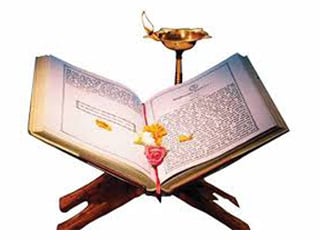
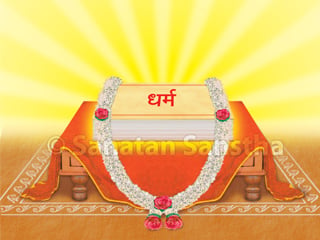 What is the true meaning of word Dharma (Righteousness) ?
What is the true meaning of word Dharma (Righteousness) ?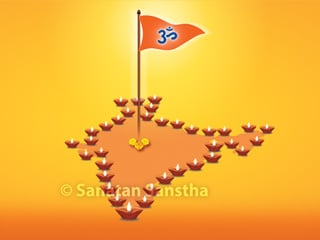 Dharma (Righteousness) and the importance of India (Bharat)
Dharma (Righteousness) and the importance of India (Bharat)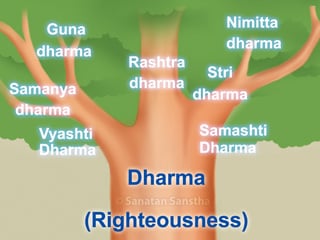 Types of Dharma (Righteousness)
Types of Dharma (Righteousness)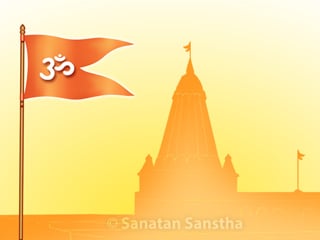 Hindu Dharma
Hindu Dharma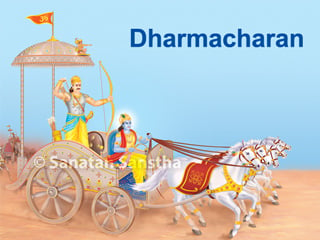 Why is it essential to adhere to Righteousness (Living Dharma) ?
Why is it essential to adhere to Righteousness (Living Dharma) ?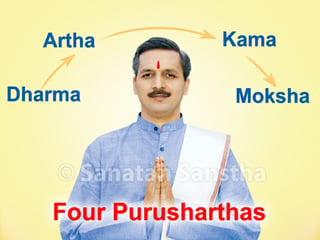 Dharmasiddhant - Principles of Hinduism (Doctrines of Dharma [Righteousness] )
Dharmasiddhant - Principles of Hinduism (Doctrines of Dharma [Righteousness] )